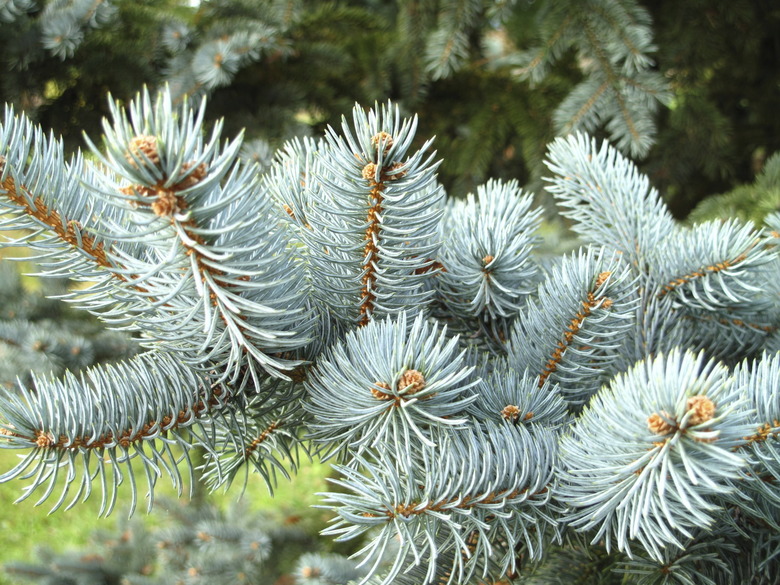Characteristics Of A Baby Blue Spruce
Found as a chance seedling growing among a nursery stand of the cultivar "Moerheimii" in Silverton, Oregon in 1972, baby blue spruce (Picea pungens "baby blue eyes") was patented under the spelling "Baby Blueyes" but is often referred to as "Baby Blue Eyes," "Baby Blueeyes," or "Baby Blue" by nurseries and in plant catalogs. Unique because of its early upright form, it is often grown for potted Christmas trees.
Step 1
Blue spruces are beloved for their striking silvery-blue foliage and "Baby Blue Eyes" is no exception. As with other types of Colorado blue spruces, "Baby Blue Eyes" has stiff, 4-angled needles with tiny white lines. The coloration of this cultivar's needles is slightly grayer than that of other cultivars. The needles grow straight out from the twigs and are secured with short leaf stems. Branches grow horizontally away from the tree and heavily shade the ground beneath.
Growth Habit
Step 1
"Baby Blue Eyes" is considered a semi-dwarf tree and tops out at about 25 feet. It can be grown from seed and is denser and slower-growing than other cultivars. But what caught its discoverer's eye was its tendency to naturally achieve the iconic pyramidal shape for which blue spruces are valued. Blue spruce culture involves grafting a desired cultivar onto a rootstock and then staking the resulting tree to achieve the upright form. "Baby Blue Eyes" achieves that growth habit on its own. Spring buds start to grow nearly two weeks after most other varieties, making it less susceptible to a late-season frost. Buds are more plentiful and grow closer together on the twigs, giving it its dense appearance.
Step 2
- Blue spruces are beloved for their striking silvery-blue foliage and "Baby Blue Eyes" is no exception.
- Spring buds start to grow nearly two weeks after most other varieties, making it less susceptible to a late-season frost.
Culture
Step 1
Hardy in USDA plant hardiness zones 2 through 8, "Baby Blue Eyes" thrives in acidic, rich, well-drained soils and prefers cooler summer temperatures. It requires full sun but will tolerate some light shade. Moist conditions are best. "Baby Blue Eyes" is moderately drought tolerant but will not tolerate flooded soils. Provide regular watering the first year to encourage deep root system development.
Uses
Step 1
Given its semi-dwarf height, a row of "Baby Blue Eyes" creates an excellent windbreak or screen. The striking foliage also makes this cultivar an excellent choice for a specimen plant or an addition to an already established, sunny garden. One of the most popular uses for this cultivar is as a potted Christmas tree. Given a large enough pot, "Baby Blue Eyes" can be used in this way for several years before transplanting is required.
Step 2
- Hardy in USDA plant hardiness zones 2 through 8, "Baby Blue Eyes" thrives in acidic, rich, well-drained soils and prefers cooler summer temperatures.
- Given a large enough pot, "Baby Blue Eyes" can be used in this way for several years before transplanting is required.
